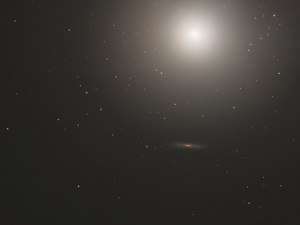Messier 89 (M89 for short, also known as NGC 4552) is an elliptical galaxy in the constellation Virgo. It was discovered by Charles Messier on March 18, 1781. M89 is a member of the Virgo Cluster of galaxies.[3]
| Messier 89[1] | |
|---|---|
 M89 by Hubble Space Telescope. | |
| Observation data (J2000 epoch) | |
| Constellation | Virgo |
| Right ascension | 12h 35m 39.8s[2] |
| Declination | +12° 33′ 23″[2] |
| Redshift | 0.001134±0.000014[2] |
| Heliocentric radial velocity | 340±4 km/s[2] |
| Galactocentric velocity | 290±5 km/s[2] |
| Distance | 50 ± 3 Mly (15.33 ± 0.92 Mpc) |
| Apparent magnitude (V) | 9.8[3] |
| Characteristics | |
| Type | E,[2] LINER,[2] HIISy2[2] |
| Apparent size (V) | 5.1 × 4.7 moa[2] |
| Other designations | |
| NGC 4552,[2] UGC 7760,[2] PGC 41968[2] | |
References: SIMBAD: Search M89 | |
Features
Current observations allow the possibility that M89 may be nearly perfectly spherical. Distinct flattening as ellipsoids is found in all easily measurable comparators up to a few times of its distance. The alternative explanation is that it is an ellipsoid oriented so that it appears spherical to an observer on Earth.
The galaxy features a surrounding structure of gas and dust, extending up to 150,000 light-years and jets of heated particles up to two-thirds of that.[4] This indicates that it may have once been an active quasar or radio galaxy.[4] M89 has an extensive and complex system of surrounding shells and plumes, indicating that it has seen one or several notable mergers.[5]
Chandra studies in the wavelength of the X-Rays show two ring-like structures of hot gas in M89's nucleus, suggesting an outburst there 1 to 2 million years ago[6] as well as ram-pressure stripping acting on the galaxy as it moves through Virgo's intracluster medium.[7] The supermassive black hole at the core has a mass of (4.8±0.8)×108 M☉.[8]
M89 also has a large array of globular clusters. A 2006 survey estimates that there are 2,000 ± 700 of these within 25′. This compares to 150 to 200 of these thought (among which many proven) to surround the Milky Way.[9]
Gallery
- Messier 89 by the Sloan Digital Sky Survey
- Map of M89
- HST image of M89
See also
References
External links
 Media related to Messier 89 at Wikimedia Commons
Media related to Messier 89 at Wikimedia Commons- SEDS: Messier Object 89
- Messier 89 on WikiSky: DSS2, SDSS, GALEX, IRAS, Hydrogen α, X-Ray, Astrophoto, Sky Map, Articles and images






